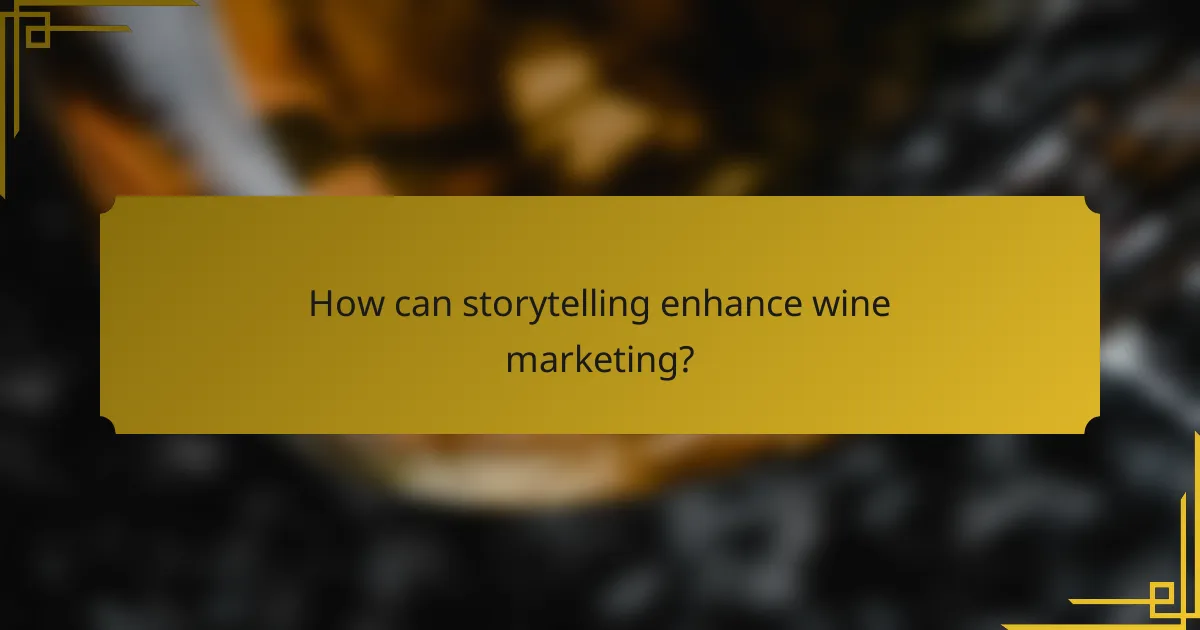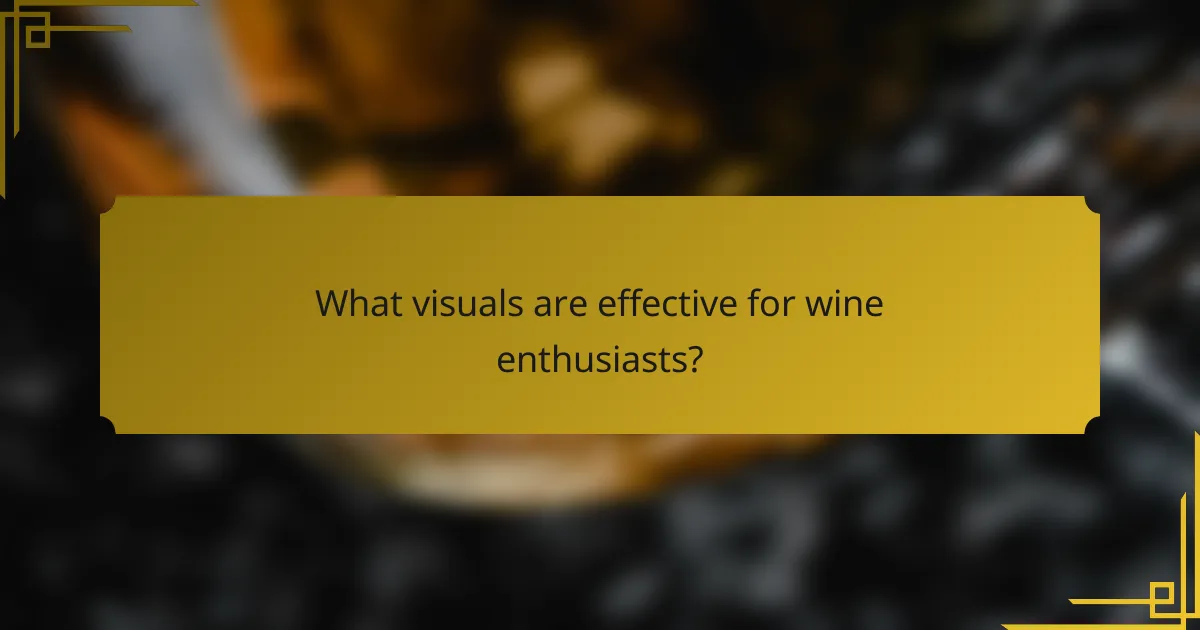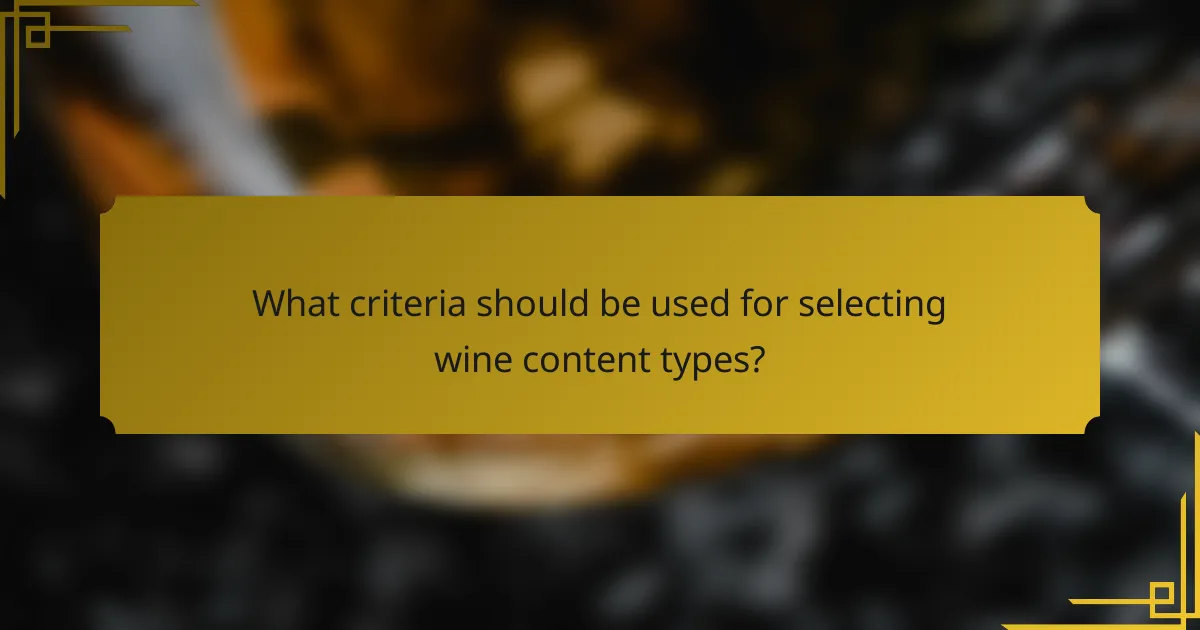In the world of wine marketing, compelling storytelling, striking visuals, and persuasive calls to action are essential for engaging enthusiasts. By crafting narratives that highlight the unique qualities and origins of wines, brands can forge emotional connections with consumers. Complementing these stories with captivating imagery and informative content enhances appreciation and understanding, while strategic calls to action drive immediate engagement and loyalty.

How can storytelling enhance wine marketing?
Storytelling can significantly enhance wine marketing by creating emotional connections and engaging customers on a deeper level. By weaving narratives around the wine’s origin, production process, and unique characteristics, brands can foster loyalty and differentiate themselves in a competitive market.
Emotional connections through narratives
Emotional connections are crucial in wine marketing, as they help consumers relate to the product beyond its taste. By sharing stories about the vineyard’s history, the winemaker’s passion, or the experiences tied to specific wines, brands can evoke feelings that resonate with potential buyers.
For example, a winery might tell the story of a family tradition that spans generations, highlighting the dedication and craftsmanship involved in each bottle. This narrative can create a sense of belonging and nostalgia, encouraging customers to choose that wine over others.
Brand identity and heritage storytelling
Brand identity is strengthened through storytelling that emphasizes heritage and authenticity. Wine enthusiasts often seek products that reflect tradition and quality, making it essential for wineries to communicate their unique stories effectively.
Wineries can showcase their geographical uniqueness, such as the terroir, climate, and local grape varieties, to build a strong brand identity. Sharing tales of the region’s culture and how it influences the wine can further enhance this connection, making the brand more memorable.
Engaging customer experiences
Engaging customer experiences can be created by incorporating storytelling into tastings, events, and marketing materials. By guiding customers through the narrative of a wine during tastings, wineries can make the experience more immersive and enjoyable.
Additionally, using visuals such as photographs or videos that complement the story can enhance engagement. For instance, showcasing the vineyard’s landscape or the winemaking process through compelling visuals can draw customers in and make the wine more appealing.

What visuals are effective for wine enthusiasts?
Effective visuals for wine enthusiasts include high-quality imagery of vineyards, informative infographics on wine pairings, and engaging video content showcasing wine production. These elements not only attract attention but also enhance understanding and appreciation of wine.
High-quality imagery of vineyards
High-quality images of vineyards play a crucial role in capturing the beauty and essence of wine regions. They evoke emotions and create a sense of place, which can be particularly appealing to wine enthusiasts. Consider using images that highlight the unique characteristics of different vineyards, such as grape varieties, seasonal changes, and landscape features.
When selecting vineyard imagery, aim for photos that are well-composed and vibrant. Images should ideally showcase the vineyard during different times of the year, providing a visual narrative of the growing process. This can help enthusiasts connect with the story behind the wine they enjoy.
Infographics on wine pairings
Infographics are an effective way to present complex information in a visually appealing format. For wine enthusiasts, infographics that illustrate wine pairings can simplify the decision-making process when selecting wines for meals. They can include charts that match specific wines with various cuisines, flavors, and occasions.
To create impactful infographics, use clear visuals and concise text. Incorporate color coding or icons to represent different wine types and food categories. This approach not only makes the information easy to digest but also encourages sharing on social media platforms, expanding reach among wine lovers.
Video content showcasing wine production
Video content that showcases wine production offers an immersive experience for wine enthusiasts. These videos can take viewers through the entire winemaking process, from grape harvesting to bottling, providing insights into techniques and traditions. This transparency can deepen appreciation for the craftsmanship involved in wine production.
When producing video content, focus on storytelling elements that highlight the unique aspects of the winery or vineyard. Include interviews with winemakers, behind-the-scenes footage, and scenic shots of the vineyard. Aim for videos that are engaging and informative, ideally lasting between 3 to 10 minutes to maintain viewer interest.

What are the best calls to action for wine subscriptions?
The best calls to action for wine subscriptions focus on enticing offers that encourage immediate engagement. Effective strategies include exclusive discounts, time-sensitive promotions, and tailored recommendations that resonate with wine enthusiasts.
Exclusive member discounts
Offering exclusive member discounts is a powerful way to attract and retain subscribers. These discounts can range from 10% to 30% off regular prices, making it financially appealing for wine lovers to join. Highlighting these savings in promotional materials can significantly boost subscription rates.
Consider implementing tiered discounts based on membership duration or purchase frequency. For example, new members might receive an introductory discount, while long-term subscribers enjoy deeper savings. This approach incentivizes loyalty and repeat purchases.
Limited-time offers on new releases
Limited-time offers on new wine releases create a sense of urgency that can drive quick decisions. By promoting these offers, you encourage subscribers to act fast, often leading to increased sales. For instance, a 20% discount on a new vintage available for only a week can motivate enthusiasts to purchase immediately.
To maximize impact, clearly communicate the time frame and availability of these offers through email campaigns and social media. Using countdown timers can visually emphasize urgency and prompt quicker responses from potential buyers.
Personalized wine recommendations
Personalized wine recommendations enhance the subscription experience by catering to individual tastes. Utilizing customer data, such as previous purchases and preferences, allows for tailored suggestions that resonate with subscribers. This can lead to higher satisfaction and increased retention rates.
Consider implementing a simple quiz or survey during the sign-up process to gather preferences. Regularly updating recommendations based on new arrivals or seasonal selections keeps the offerings fresh and engaging, ensuring subscribers feel valued and understood.

How to create compelling content for wine clubs?
Creating compelling content for wine clubs involves engaging storytelling, informative visuals, and effective calls to action. This approach helps to attract and retain members by fostering a sense of community and enhancing their wine experience.
Member spotlights and testimonials
Highlighting member spotlights and testimonials can significantly enhance the sense of belonging within a wine club. Share stories of members’ journeys with wine, their favorite selections, and how the club has enriched their experiences.
Consider featuring a monthly spotlight on a member, showcasing their preferred wines and personal anecdotes. This not only personalizes the club but also encourages other members to share their stories, creating a vibrant community atmosphere.
Educational content about wine regions
Providing educational content about various wine regions can deepen members’ appreciation for wine. Focus on the unique characteristics of regions such as Napa Valley, Bordeaux, or Tuscany, including climate, grape varieties, and winemaking techniques.
Incorporate articles, infographics, or videos that explore these regions. For example, a visual guide to the terroir of different regions can help members understand how location influences flavor profiles. This knowledge can enhance their tasting experiences and purchasing decisions.
Interactive tasting events
Hosting interactive tasting events is an effective way to engage wine club members. These events can be in-person or virtual, allowing members to sample wines while learning about their origins and tasting notes.
Consider organizing themed tastings, such as “Wines of Spain” or “Sustainable Wines,” where members can explore specific topics. Providing tasting kits with selected wines and educational materials can enhance the experience, making it both enjoyable and informative.

What criteria should be used for selecting wine content types?
Selecting wine content types should focus on audience engagement, content format effectiveness, and alignment with brand messaging. These criteria ensure that the content resonates with wine enthusiasts and effectively communicates the desired message.
Audience engagement metrics
To gauge audience engagement, track metrics such as likes, shares, comments, and time spent on content. High engagement often indicates that the content resonates well with wine enthusiasts, prompting them to interact more. Aim for a balanced mix of qualitative feedback and quantitative data to refine your content strategy.
Consider using tools like Google Analytics or social media insights to monitor these metrics. Regularly evaluate which types of content generate the most engagement, and adjust your strategy accordingly to enhance connection with your audience.
Content format effectiveness
Different content formats can significantly impact how wine enthusiasts consume information. For instance, visually appealing infographics may attract attention, while detailed articles can provide in-depth knowledge. Experiment with formats such as videos, podcasts, and interactive quizzes to determine what works best for your audience.
When selecting formats, consider the complexity of the information and the preferences of your target demographic. For example, younger audiences might prefer short videos, while older wine enthusiasts may appreciate longer, informative articles.
Alignment with brand messaging
Ensuring that your wine content aligns with your brand messaging is crucial for maintaining consistency and building trust. Clearly define your brand’s voice and values, and reflect these in your content choices. For example, if your brand emphasizes sustainability, highlight organic wines and eco-friendly practices in your content.
Regularly review your content to ensure it supports your overall brand narrative. This alignment not only strengthens brand identity but also fosters loyalty among wine enthusiasts who share similar values.

How can wine brands leverage social media storytelling?
Wine brands can effectively use social media storytelling to engage their audience by sharing authentic narratives, showcasing their unique processes, and creating emotional connections. This approach not only highlights the brand’s personality but also fosters community among wine enthusiasts.
Instagram stories for behind-the-scenes content
Instagram stories are an excellent way for wine brands to provide behind-the-scenes glimpses into their operations. This could include vineyard tours, the winemaking process, or even day-to-day activities at the winery. By sharing these authentic moments, brands can build a stronger connection with their audience.
Utilizing features like polls and questions in stories can encourage interaction, making followers feel more involved. For example, asking followers to vote on their favorite grape variety can create engagement while educating them about the brand’s offerings.
Facebook live tastings and Q&As
Facebook Live tastings and Q&A sessions allow wine brands to connect with their audience in real-time. During these events, brands can showcase different wines, discuss tasting notes, and answer questions directly from viewers. This interactive format helps to demystify wine and makes it more accessible to enthusiasts.
To maximize participation, brands should promote these events in advance and consider scheduling them during peak engagement times, such as evenings or weekends. Offering exclusive discounts or giveaways during the live session can also incentivize viewers to join.
Influencer partnerships for wider reach
Partnering with influencers can significantly expand a wine brand’s reach on social media. By collaborating with wine enthusiasts or lifestyle influencers, brands can tap into established audiences that share a passion for wine. This strategy not only enhances visibility but also lends credibility to the brand.
When selecting influencers, it’s crucial to choose those whose values align with the brand’s identity. Micro-influencers, who often have more engaged audiences, can be particularly effective for niche markets. Brands should also encourage influencers to share personal stories about their experiences with the wine, adding authenticity to the promotion.
